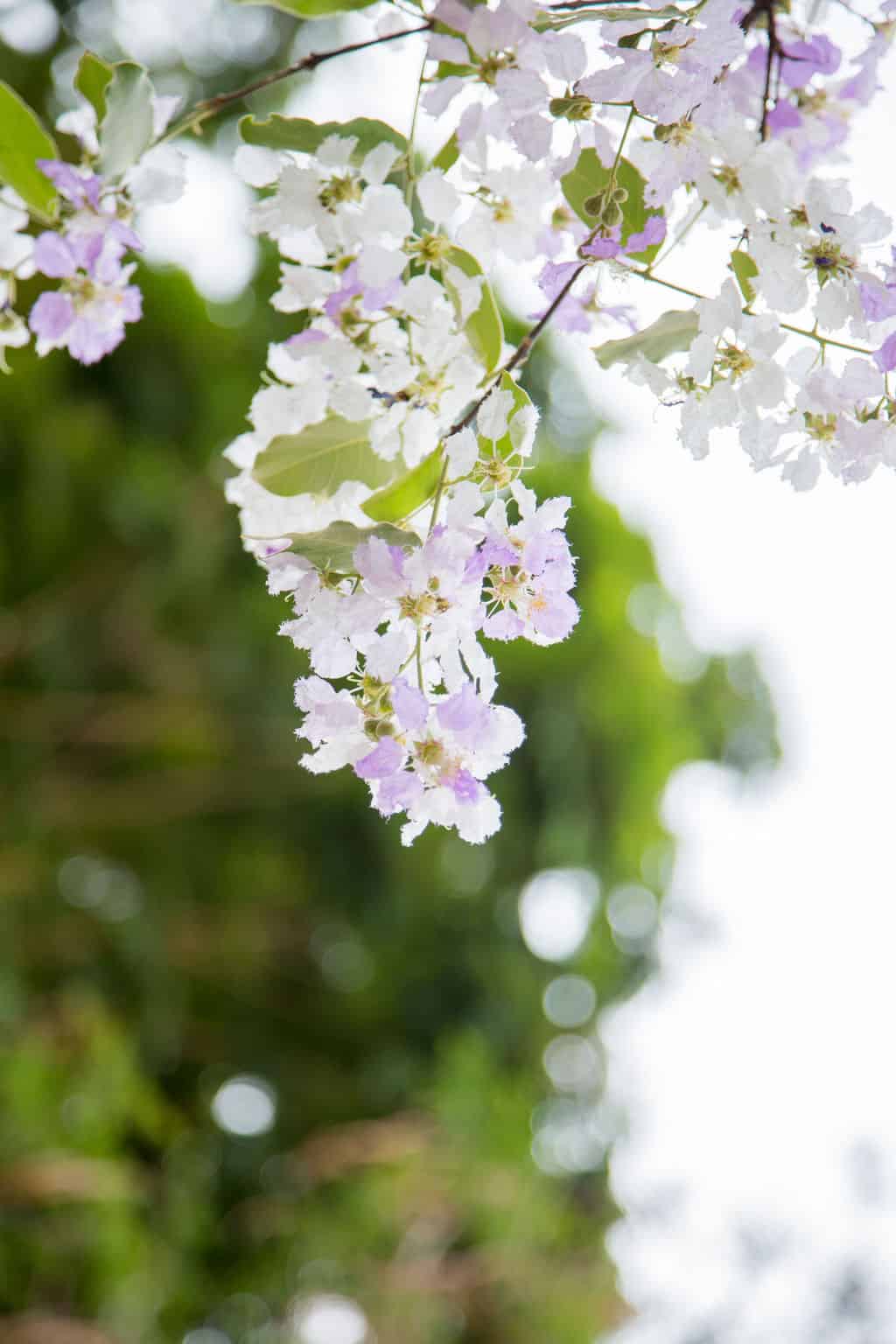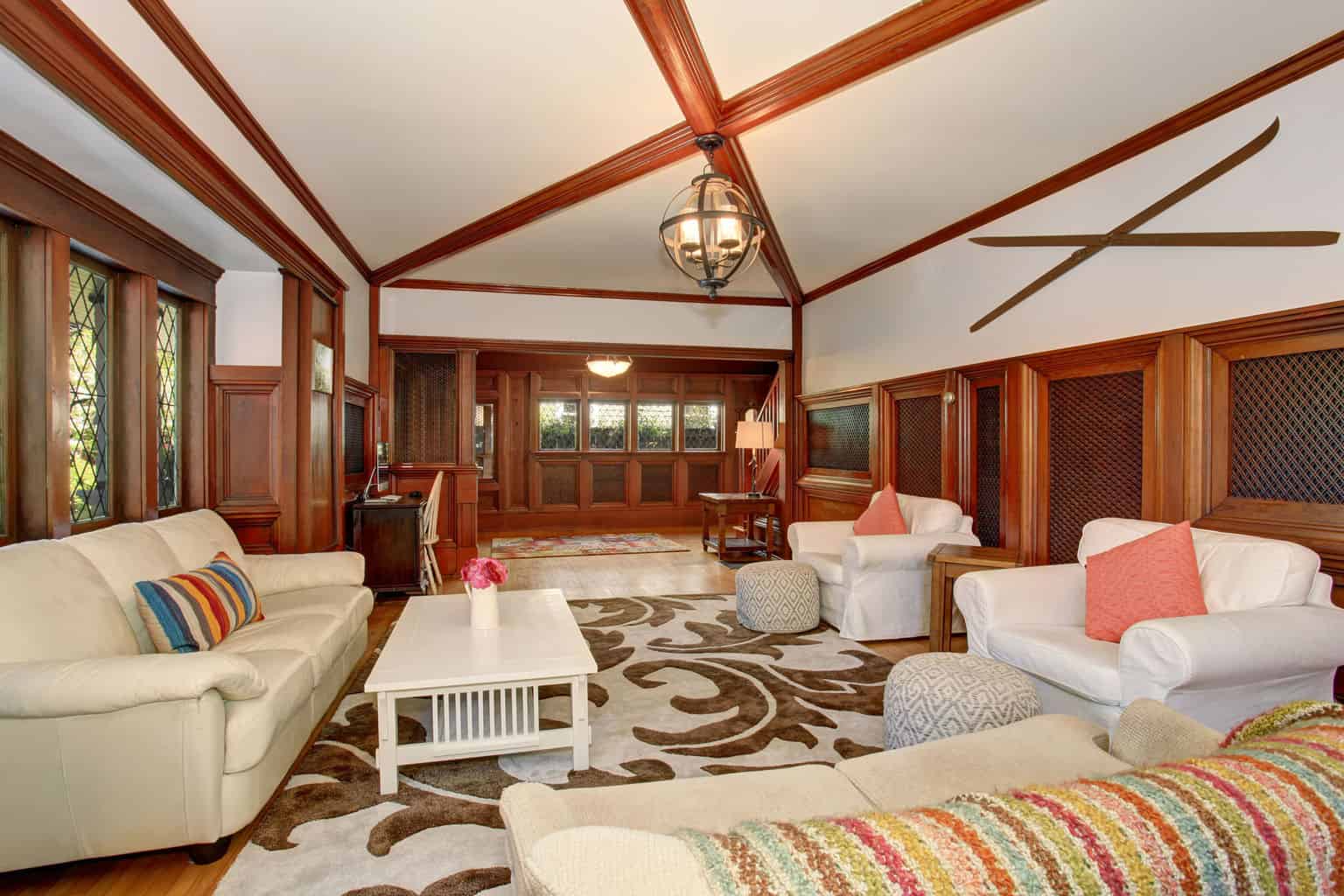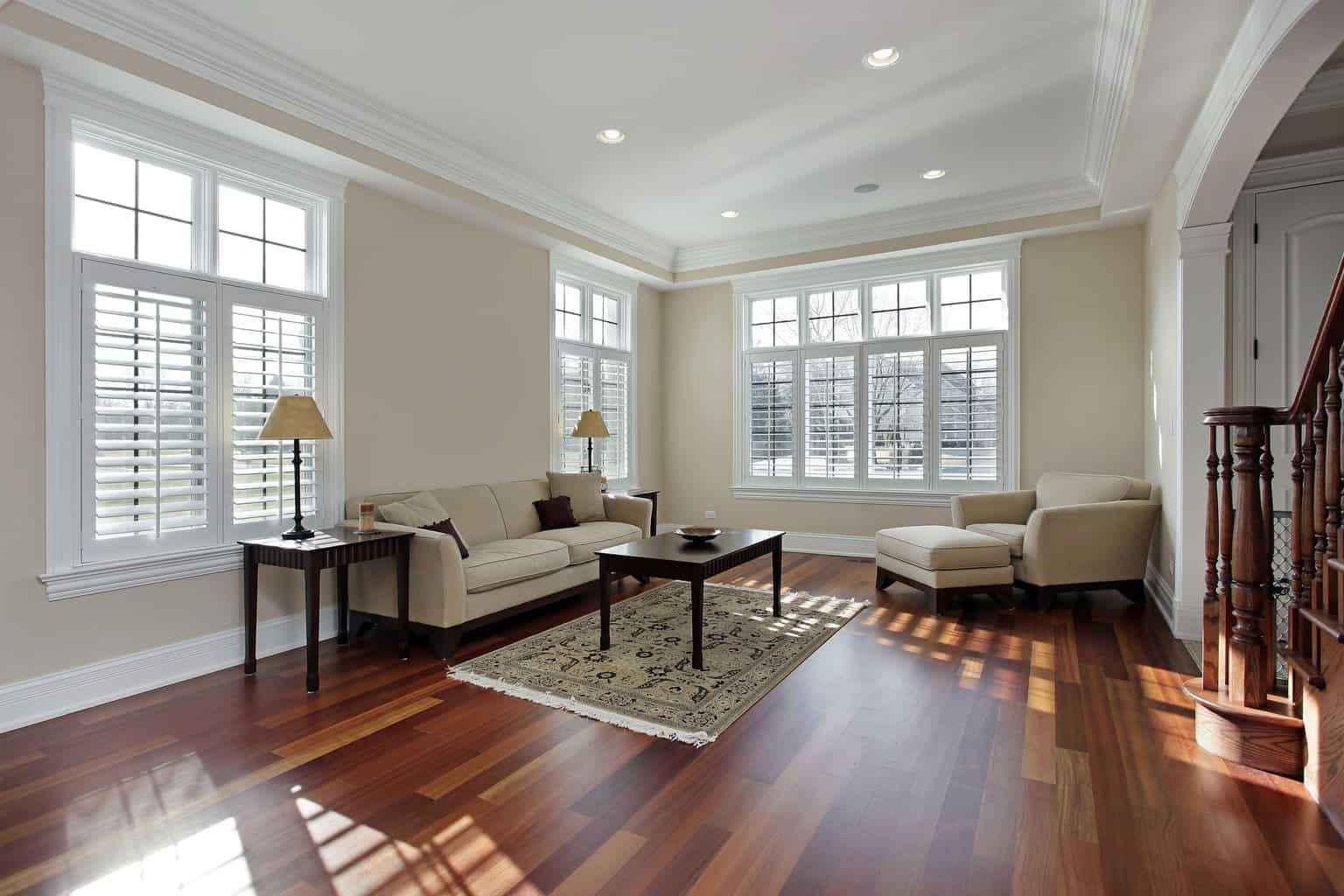Perhaps the first thing people think about when they hear “cherry tree” is the old parable regarding a young George Washington chopping down his father’s tree. In addition to having lovely blossoms and making a gorgeous landscaping statement, cherry wood is a great material for hardwood flooring because of its rich and distinctive coloring.
Cherry wood’s color varies from a rich red to a reddish brown and its color darkens with age due to oxidation. When used for flooring cherry provides you with a satiny, smooth texture that adds warmth and character to any home. The wood from cherry trees, prunes species, a subset of the rose family, has been used in furniture making since 400 BC.

Advantages and Disadvantages of Cherry Wood Flooring
Some of the advantages of using cherry for your home’s flooring are:
- Produces an excellent and smooth finish
- Is readily available as an unfinished or prefinished flooring material
- Is easy both to clean and to maintain
However, as with all wood flooring, cherry flooring has its disadvantages too and these include:
- Fading
- Easily scratched by dirt and grit
- Damaged by excess moisture

How Can You Tell If This Is The Floor For You?
There are five questions you should investigate if you are considering selecting cherry hardwood flooring for your home:
- What kind of cherry wood do I want to use for my flooring?
- Will cherry hardwood accentuate or distract from the style of my home?
- Is cherry going to be a durable enough flooring option for me?
- How much can I expect to pay for a cherry hardwood flooring?
- From where should I purchase cherry hardwood flooring?
What Kind of Cherry Wood Do I Want to Use For My Flooring?
The answer here is really going to depend on what style you are looking for, the overall look you want to achieve, in what kind of room you plan to install the cherry flooring, and your budget. Cherry trees are grown worldwide, although not all are used for flooring material. Brazilian cherry is by far the most popular cherry hardwood flooring used, but the Asian and Bolivian cherry varieties can also be used. Cherry hardwood planks are easy to machine, glue and nail well and so are easy to install, and result with a smooth finish when sanded. Cherry wood also dries quite quickly after milling, but has a high shrinkage rate unless it has been kiln dried.

Each species of cherry hardwood flooring has a different Janka rating. The Janka hardness rating is the measure of hardness for all wood varieties used for flooring. The American Cherry hardwood has the lowest score of the cherry wood varieties, with a rating of only 950. The Janka rating of other cherry woods is Brazilian cherry – 2820, African cherry – 1010, and Bolivian cherry – 3190. Lumber liquidators has a helpful chart that can be found here that will show you a comparison of the Janka ratings of many different hardwood varieties.
Cherry flooring has been used for many decades in the construction industry. The flowering version of the tree that has been made famous by Washington D.C.’s Cherry Blossom Festival was introduced to America in 1900 as a gift from Japan. American cherry wood is softer than all of the other cherry woods, so it is not as popularly used for flooring as it is in landscaping. Brazilian or Jatoba cherry is an imported exotic hardwood and is the much more popular flooring choice.
Will Cherry Wood Accentuate or Distract From the Style of My House?
Selecting the right wood, possibly Brazilian or Bolivian hardwood cherry flooring, you will enjoy its unique grain and deep color for years to come. I personally love the look of cherry wood flooring, as it is noticeable, makes a statement, and unique in appearance, but will not draw the focus or overwhelm the other features of a room. It pairs well with almost any décor style and gives off a homey feeling that isn’t lacking in luster.

Cherry hardwood floors have an excellent smooth finish that is durable and adds warmth to any room. Brazilian cherry hardwood flooring has an open-grained appearance similar to that of oak but is twice as hard. An interesting feature of cherry hardwood flooring is the dark brown or black streaks that contrast with its background, ranging from dark orange to reddish brown. It is important to note, however, that Brazilian cherry hardwood flooring darkens after several months, so this should be taken into account when considering using it for flooring. Cherry hardwood flooring is readily available and is one of the most commonly used hardwoods in America.
Is Cherry Going to be a Durable Enough Flooring For Me?
Select your cherry flooring carefully because some cherry woods are significantly softer than others. As with other wood floors, cherry has the advantage of being easy to clean and maintain. When choosing a cherry wood flooring, most lean towards the Brazilian variety that is significantly stronger and has a measure of hardness rating that is significantly higher than many other hardwood flooring varieties, including pine and oak. You will need to seal or wax a cherry wood floor, and as with any type of hardwood flooring, that will need to be re-done occasionally, according to the manufacturer’s instructions. Brazilian cherry hardwood flooring is available in pre-finished or unfinished, and in thicknesses ranging from 3/8″ to 3/4”.
Unlike carpeting, hardwood flooring does not collect dust readily, so a dust mop is ideal for daily cleaning and damp mopping your cherry floor will remove dirt and grime. Wet mopping of wooden floors is not advisable and can lead to warping. Always ensure that you use a damp mop and your cherry hardwood floors will retain their shine, luster, and appeal.

By not taking care of your cherry flooring you will see a loss of shine and luster. When exposed to strong, direct sunlight tends to bleach out, losing its coloring. Filtering the light through a window film or window coverings can help to prevent this. Dirt and grit can act like sandpaper, scratching the finish and eventually the wood. Placing rugs and mats at doorways helps reduce this problem. Spills can damage the finish and even warp the wood, if not wiped up quickly. Because of wood’s natural tendency to absorb moisture, it is often recommended to avoid placing cherry flooring in kitchens, bathrooms, or laundry areas.
Bolivian cherry hardwood flooring can have provide some challenges. When sanding this wood, the dust can cause allergic reactions, such as contact dermatitis and respiratory allergies. Oil finishes do not dry properly, making water-based finishes a better choice.
How Much Can I Expect to Pay for a Cherry Hardwood Flooring?
Cherry wood is comparable in price per square footage to most other hardwoods. You can expect to pay about $2-$5 per square foot when purchasing cherry hardwood flooring planks, and installation costs are typically about the same as with any other hardwood flooring. With installation, you may expect to see costs of around $4-$8 per square foot for cherry hardwood floors. Because it is grown and harvested locally, American cherry wood is significantly less expensive than the more common (and stronger) Brazilian cherry wood, which comes from the jatoba tree native to the jungles of the Amazon.

There are, of course, less expensive options to achieve the look of cherry hardwood floors without paying for the solid hardwood planks. There are laminate flooring options comprised of cherry hardwood layered over a wood composite, or even vinyl or tile options designed to mimic the look of a natural cherry hardwood floor.
From Where Should I Purchase Cherry Hardwood Flooring?
I get asked this question a lot. People are always coming to me looking for reputable providers of certain varieties of hardwoods and my answer does really vary depending on the particular hardwood species you are looking for and whether you are sold on purchasing a solid hardwood flooring or are considering other options, such as a laminate flooring designed to look like a cherry hard wood. When purchasing a Brazilian cherry hardwood flooring, it is important to purchase from someone reputable who uses sustainable practices, as the jatoba tree is one of many that have been over-harvested, contributing to the deforestation of the Amazon. You can check with Forestry Stewardship Council on sustainable practices and do research before purchasing any hardwood flooring. Typically, my advice is that if a price seems too good to be true, it usually is. Do market comparisons and get feedback and reviews before making any kind of major home purchase, including flooring.

When considering flooring options for your home or office, cherry hardwood flooring makes for an interesting and dramatic choice. Not only will cherry hardwoods add warmth and elegance to a room, but will also increase the resale value. Since you can readily buy cherry hardwood floors from any hardwood specialty stores, you won’t have trouble finding a quality, beautiful flooring that fits your tastes. You also won’t have to resort to chopping your own cherry tree, like George Washington!

What are you using on them? Yes, you’ll be having this problem for a while until the dust finally clears…….
Your safest bet is to use something that’s considered ‘environmentally friendly’, doesn’t build up, etc. I’m not sure what product(s) to specifically recommend since this site is devoted to flooring issues. Thanks for dropping in!
Hi,
I started building homes and I finished the 3rd one 7 months ago and it has not sold yet. I put Washington Cherry on all the floors except the kitchen and baths. Unfortunately, I put down paper walkway runners. On December 27th I went to clean a little in anticipation for a showing on New Years Day. I looked under the paper protective walkways and I am in shock due to the lighter floor color under all the walkways that I made. I understand that it will take some time for the color to even up after I remove the paper, but can anyone tell me how long and has anyone seen it actually catch up with the darker part………I am desperate for the answer……I am looking at probably 20,000 dollars worth of flooring and labor to redo the floors……there goes my income from the house sale……and that is IF I can sell it with the way it looks now.
Would a UV light lamp work to even up a cherry floor on the areas that were not exposed to light and are presently lighter.
Hi Deborah,
Yes, a UV light would probably help since it’s the UV rays from sunlight that reacts with the cherry wood to give it it’s beautiful color. I don’t know how long it would take to even up the color tones though, it all reacts differently and depends on how much exposure to sunlight the floor gets as well.
It is not UV but light, and especially strong light, that both fades fabrics and darkens woods as in your cherry floors. So you don’t need a UV lamp–which is dangerous to run while people are around. you just need a strong light source. It is a common misunderstanding that UV is what affects both fabrics and wood, but ask any physicist if UV could possibly penetrate glass (and especially double-panes as most are now). The answer will always be NO. This is why your arm gets sunburned if you put it in your car’s open window, but doesn’t sunburn–even if it feels uncomfortably hot–when your arm is inside with the window rolled up.
Maybe I should be more specific to deter a lot of disagreement. Not ALL of the UV will be filtered out by ordinary double-pane window glass, but certainly enough to make UV a minor consideration. Almost all of the more energetic wavelengths (above 350nm) will be filtered out. About half the less energetic UV (less than 350nm) does get through. This is the lowest part of the UV-A band. This is not usually enough to do anything, although I guess you could get some skin damage if you sat all day in the sun inside your double-pane window. But I doubt you’d tan. And I doubt this is why your floor darkens, considering all the other wavelengths in sunshine, and the strength of those sunbeams.
Thanks for you input Ron and for the clarification.
Hi…I’m hoping you can help. We put in about 1,000 square feet of brazilian cherry a couple of years ago. It is beautiful but EXTREMELY time-consuming and high maintenance. When we clean them…they look good for only a matter of hours, before they start showing absolutely everything…feet marks (we have two small boys), dust (we live in the country), etc. We have tried absolutely everything, and they are so gorgeous when we clean them, but honestly…I cannot clean them every single day. Someone recently suggested distressing them or bleaching them to help with the maintenance–the logic being that they wouldn’t show as much of the daily grime. What do you think? How would we do this?
Hi Mary,
Why would you want to bleach the wood floor? It sounds more like a problem with the finish – what kind of product/s have you used on the wood? Was is pre-finished?
We thought about bleaching because lighter floor don’t show as much. We have pine upstairs and those floors are much, much less work.
I vacuum our cherry floors, then do a damp mop. I have to get on my hands and knees to really clean them. Sometimes (maybe once every 4 months), we apply Bona swedish floor cleaner.
Thank you!!!
Hi Mary,
I don’t know how damaging it would be to your cherry floors if you bleached them, so I’m not going to recommend it. The floors are yours, you can do what you want obviouslty, at your own risk.
Did Deborah ever get the color discoloration in her cherry floor solved? I have installed brazilian cherry in my daylit basement about 6 months ago. It has darkened wonderfully near the windows and doors, but not in the center of the room. I am trying to wait until I see relatively even coloring before I furnish the room. We plan to put a pool table inthe room which obviously will not get moved around, so I don’t want to end up with discolorations under furniture if we ever move out of the house. I have been thinking about getting some sort of lamp too and was wondering it worked for Deborah. Thanks.
Hi Beth,
I haven’t heard anything as of yet.
how do you stain a brazillian cherry floor ( nothing but problems ) every seam ends and sides shows white,floor stained dark walnut. Can you stain a cherry floor
Hi Al,
You mentioned that it was already stained dark walnut. You could always use more stain at the seam ends & sides – working quickly. If it was sealed after staining, you’ll have to strip the sealer. Brazillian cherry flooring changes color over time too, perhaps as the floor ages the color will deepen naturally, though I’m not sure how good it will look since it’s been stained with dark walnut.
What are your thoughts on the new “steam mops” for cleaning Brazilian Cherry Hardwood? The TV makes it sound like a good way to clean your hardwoods. If in fact, the steam dries quickly as the commercials show, is there a difference then damp mopping? Thanks for your help.
Hi,
I’m looking a purchasing a house that’s 5 years old and has 3/4″ Japanese Cherry Hardwood in it. (I live in an area with quite dry climate and winters 5-6 months long.)Needless to say there is some shrinkage in the floors. Some areas worse than others. Is there some kind of maintainence, humidifer etc, that can reduce or reverse the amount of shrinkage. If not, is there an amount of shrinkage I can still expect to come or do you think it has shrunk as much as it will?
Thanks for the info
Sandra
Hi Jodie,
I’ve heard reports – both good and bad – about using a steam mop to clean wood floors. Personally, I can’t say either way, I don’t have a steam mop because I’m concerned that it may damage my flooring.
Hi Sandra,
You shouldn’t get any more shrinkage after this long. There really isn’t a whole lot you can do about this, but at least it shouldn’t get any worse. Does the furnace/AC have a humidifier built in? Often they do. Don’t know if it will help much since I don’t know what part of the country you’re in. My guess is the flooring wasn’t acclimated well (if at all) before it was installed. How wide are the gaps?
What type of steam mop do you recommend to clean cherry floors?